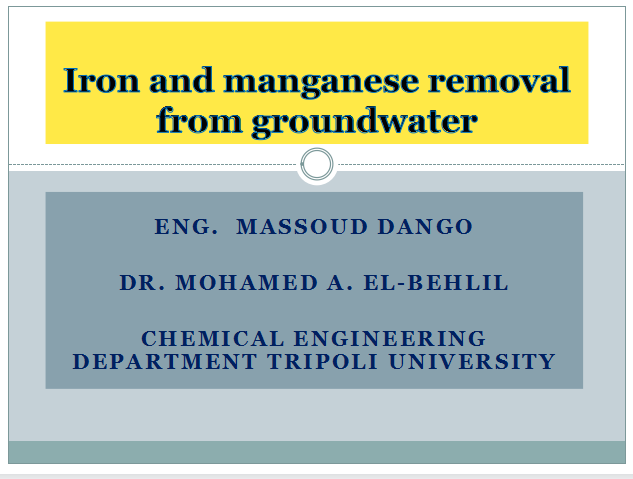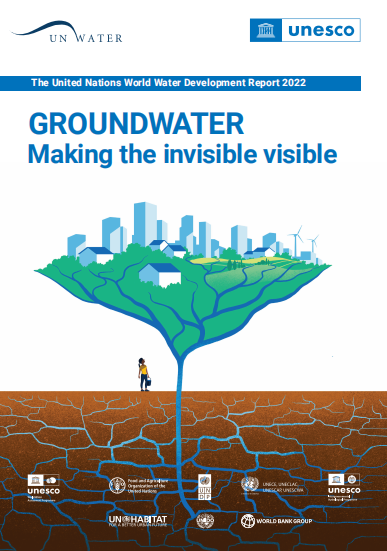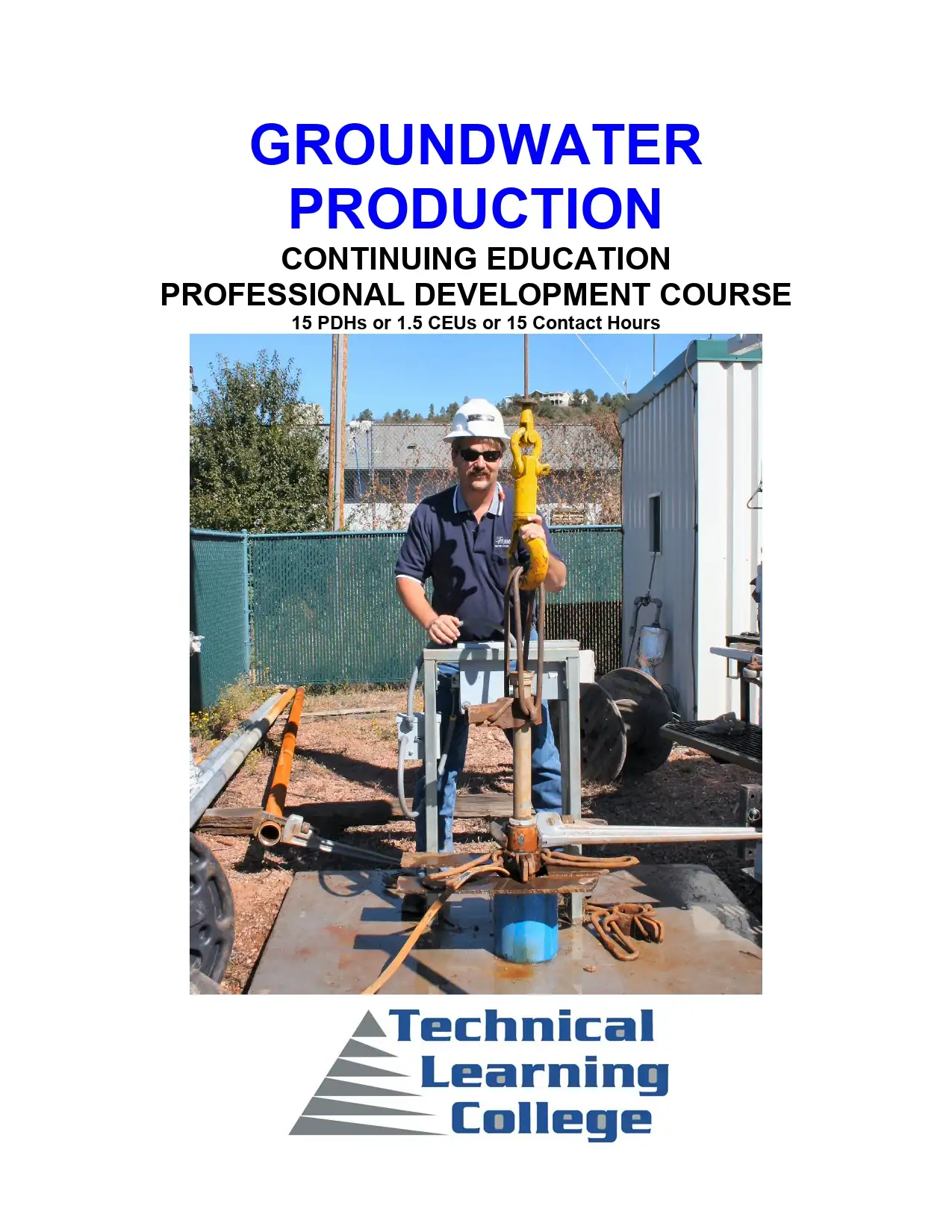Iron And Manganese Removal From Groundwater
Treatment of Groundwater for the removal of Iron and Manganese
Presented by: Eng. Massoud Dango , Dr. Mohamed A. El-Behlil
Usually dispatched in 2 to 3 days
Usually dispatched in 2 to 3 days
Category:
Wells & Groundwater
Only logged in customers who have purchased this product may leave a review.
Related products
Removal of Hazardous Metals from Groundwater by Reverse Osmosis
Abstract:
This EPA treatment technology project was designed to collect data on the performance of existing water treatment processes in order to remove arsenic on pilot-scale. Our paper contains verification testing of the reverse osmosis membrane module conducted over a 30-day period at the Spiro Tunnel Bulkhead water (Park City, Utah, USA), which is considered to be a ground water. The total arsenic concentration in the feed water averaged 60 ppb during the test period and was reduced to an average of 1 ppb in the treated (permeate) water. The work reported here focused on obtaining accurate readings for arsenic valence states (III) and (V), using an anion exchange resin column. The dominant arsenic species in the abandoned silver mine tunnel feed water was As(V). Results of analysis showed that 70% of the arsenic present in the feed water was in dissolved form. Arsenic speciation for valence states (III) and (V) showed that arsenic (V) represented 76% of the dissolved arsenic in the source water. The method detection limit (MDL) for arsenic using ICP-MS was determined to be 0.1 ppb. Our matrix spiked recovery, spiked blank samples and reference materials deviated only a few percentage points from the listed true values.
Removal of Hazardous Metals from Groundwater by Reverse Osmosis
Abstract:
This EPA treatment technology project was designed to collect data on the performance of existing water treatment processes in order to remove arsenic on pilot-scale. Our paper contains verification testing of the reverse osmosis membrane module conducted over a 30-day period at the Spiro Tunnel Bulkhead water (Park City, Utah, USA), which is considered to be a ground water. The total arsenic concentration in the feed water averaged 60 ppb during the test period and was reduced to an average of 1 ppb in the treated (permeate) water. The work reported here focused on obtaining accurate readings for arsenic valence states (III) and (V), using an anion exchange resin column. The dominant arsenic species in the abandoned silver mine tunnel feed water was As(V). Results of analysis showed that 70% of the arsenic present in the feed water was in dissolved form. Arsenic speciation for valence states (III) and (V) showed that arsenic (V) represented 76% of the dissolved arsenic in the source water. The method detection limit (MDL) for arsenic using ICP-MS was determined to be 0.1 ppb. Our matrix spiked recovery, spiked blank samples and reference materials deviated only a few percentage points from the listed true values.
Iron And Manganese Removal From Groundwater
Abstract:
Drinking water supplies are based on ground water resources all over the world. At some localities problems with higher concentrations of iron and manganese found in ground water. These higher concentration of these metals result in metallic taste of water, effect color and flavor of food and cause staining of different products like paper, cloths, and plastics. Therefore World Health Organization has approved the treatment of water if concentrations of iron and manganese are higher than 0.3mg/L and 0.1 mg/L. Several techniques have been applied to remove iron and manganese from groundwater. The issue of higher concentrations of iron and manganese in groundwater wells at Grindalsmoen in Elverum Municipality in the south eastern part of Norway has been investigated by a PHREEQC geochemical model. The aim of this investigation was to analyze the relationships between oxygen levels and precipitation rates of iron and manganese. For this purpose geochemical simulations were performed with PHREEQC model with radial and linear flow. Results proved that concentration of oxygen at the water works (at its corresponding partial pressure) is high enough to precipitate the level of iron and manganese found in groundwater. The concentration of oxygen in equilibrium air at our desired temperature of 6 degree centigrade was 12.3 mg/l calculated by PHREEQC. Geochemical simulations were performed by the one dimensional column flow and radial flow towards well. The phenomenon of sorption was also included in model to see the adsorption behavior of iron and manganese. Overall this geochemical study has provided satisfactory results.
Iron And Manganese Removal From Groundwater
Abstract:
Drinking water supplies are based on ground water resources all over the world. At some localities problems with higher concentrations of iron and manganese found in ground water. These higher concentration of these metals result in metallic taste of water, effect color and flavor of food and cause staining of different products like paper, cloths, and plastics. Therefore World Health Organization has approved the treatment of water if concentrations of iron and manganese are higher than 0.3mg/L and 0.1 mg/L. Several techniques have been applied to remove iron and manganese from groundwater. The issue of higher concentrations of iron and manganese in groundwater wells at Grindalsmoen in Elverum Municipality in the south eastern part of Norway has been investigated by a PHREEQC geochemical model. The aim of this investigation was to analyze the relationships between oxygen levels and precipitation rates of iron and manganese. For this purpose geochemical simulations were performed with PHREEQC model with radial and linear flow. Results proved that concentration of oxygen at the water works (at its corresponding partial pressure) is high enough to precipitate the level of iron and manganese found in groundwater. The concentration of oxygen in equilibrium air at our desired temperature of 6 degree centigrade was 12.3 mg/l calculated by PHREEQC. Geochemical simulations were performed by the one dimensional column flow and radial flow towards well. The phenomenon of sorption was also included in model to see the adsorption behavior of iron and manganese. Overall this geochemical study has provided satisfactory results.
Groundwater Production
Course Description
GROUNDWATER PRODUCTION CEU TRAINING COURSE
This short CEU training course is a detailed explanation of Water Distribution and Water Treatment Methods and related water fundamentals along with detailed understanding pumps and motors. This is an excellent course that applies to both Water Treatment and Distribution Operators. This course also covers in detail: Disinfection, Chlorine, O3 and disinfection alternatives, and related byproduct fundamentals. Water Quality, Tastes and Odor Problems and MCL/EPA Rules and a basic understanding of how the rules were created and implemented will be covered. This course will also cover advanced groundwater production and protection with distribution problem solving solutions.
Groundwater Production
Course Description
GROUNDWATER PRODUCTION CEU TRAINING COURSE
This short CEU training course is a detailed explanation of Water Distribution and Water Treatment Methods and related water fundamentals along with detailed understanding pumps and motors. This is an excellent course that applies to both Water Treatment and Distribution Operators. This course also covers in detail: Disinfection, Chlorine, O3 and disinfection alternatives, and related byproduct fundamentals. Water Quality, Tastes and Odor Problems and MCL/EPA Rules and a basic understanding of how the rules were created and implemented will be covered. This course will also cover advanced groundwater production and protection with distribution problem solving solutions.
Well Design And Construction For Monitoring Groundwater At Contaminated Sites
Purpose and Scope of this Document:
The purpose of this guidance document is to present a recommended approach to designing and constructing monitoring wells for groundwater investigations at contaminated sites. The state-of-practice of environmental characterization has changed substantially since 1995, when the original guidance was released. The intent of this revised guidance is to update the original guidance regarding recent developments and to discuss groundwater monitoring wells within the context of recent developments. In that regard, the overview below provides a thumbnail sketch of the differences between this document and the original guidance.
Well Design And Construction For Monitoring Groundwater At Contaminated Sites
Purpose and Scope of this Document:
The purpose of this guidance document is to present a recommended approach to designing and constructing monitoring wells for groundwater investigations at contaminated sites. The state-of-practice of environmental characterization has changed substantially since 1995, when the original guidance was released. The intent of this revised guidance is to update the original guidance regarding recent developments and to discuss groundwater monitoring wells within the context of recent developments. In that regard, the overview below provides a thumbnail sketch of the differences between this document and the original guidance.
Distribution Foreman
Distribution Foreman CEU Training Course Description
Water Distribution, Well Drillers, Pump Installers, and Water Treatment Operators. The target audience for this course is the person interested in working in a water treatment or distribution facility and wishing to maintain CEUs for certification license or to learn how to do the job safely and effectively, and/or to meet education needs for promotion. This course will cover the necessary water distribution information for the intermediate level of water distribution/water treatment operator. This course consists of 4 chapters of increasing subject/task difficulty. Because of the explanation of Water Distribution and Water Treatment Methods and related water fundamentals and a detailed understanding of pumps and motors, this is an excellent course that applies to both Water Treatment and Distribution Operators. This course also covers in detail: Disinfection, Chlorine, O3 and disinfection alternatives, and byproduct fundamentals. Water Quality, Tastes, and Odor Problems, MCL/EPA Rules, and a basic understanding of how the rules were created and implemented will be covered. This course will also cover advanced groundwater production and protection with problem-solving solutions.
Distribution Foreman
Distribution Foreman CEU Training Course Description
Water Distribution, Well Drillers, Pump Installers, and Water Treatment Operators. The target audience for this course is the person interested in working in a water treatment or distribution facility and wishing to maintain CEUs for certification license or to learn how to do the job safely and effectively, and/or to meet education needs for promotion. This course will cover the necessary water distribution information for the intermediate level of water distribution/water treatment operator. This course consists of 4 chapters of increasing subject/task difficulty. Because of the explanation of Water Distribution and Water Treatment Methods and related water fundamentals and a detailed understanding of pumps and motors, this is an excellent course that applies to both Water Treatment and Distribution Operators. This course also covers in detail: Disinfection, Chlorine, O3 and disinfection alternatives, and byproduct fundamentals. Water Quality, Tastes, and Odor Problems, MCL/EPA Rules, and a basic understanding of how the rules were created and implemented will be covered. This course will also cover advanced groundwater production and protection with problem-solving solutions.
Distribution Basics II
DISTRIBUTION BASICS CEU TRAINING COURSE Second Edition
Review of water distribution systems and related treatment fundamentals. This course will cover the basic requirements of the Safe Drinking Water Act and general water distribution principles. You will not need any other materials for this course. Water Distribution, Well Drillers, Pump Installers, and Water Treatment Operators. The target audience for this course is the person interested in working in a water treatment or distribution facility and/or wishing to maintain CEUs for certification license or to learn how to do the job safely and effectively, and/or meet education needs for promotion.
Final Examination for Credit
The opportunity to pass the final comprehensive examination is limited to three attempts per course enrollment.
Distribution Basics II
DISTRIBUTION BASICS CEU TRAINING COURSE Second Edition
Review of water distribution systems and related treatment fundamentals. This course will cover the basic requirements of the Safe Drinking Water Act and general water distribution principles. You will not need any other materials for this course. Water Distribution, Well Drillers, Pump Installers, and Water Treatment Operators. The target audience for this course is the person interested in working in a water treatment or distribution facility and/or wishing to maintain CEUs for certification license or to learn how to do the job safely and effectively, and/or meet education needs for promotion.
Final Examination for Credit
The opportunity to pass the final comprehensive examination is limited to three attempts per course enrollment.















Reviews
There are no reviews yet.